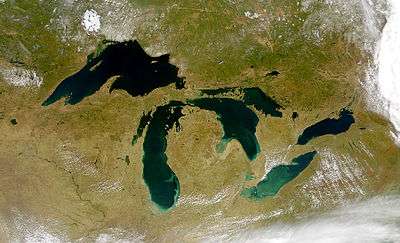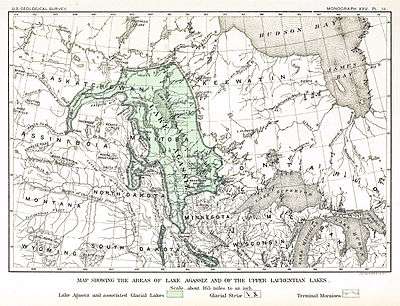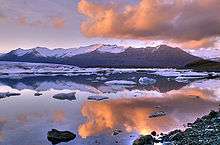Glacial lake







A glacial lake is a lake with origins in a melted glacier. They are formed when a glacier erodes the land, and then melts, filling the hole or space that it has created. Near the end of the last glacial period, roughly 10,000 years ago, glaciers began to retreat.[1] A retreating glacier often left behind large deposits of ice in hollows between drumlins or hills. As the ice age ended, these melted to create lakes. This is apparent in the Lake District in Northwestern England where post-glacial sediments are normally between 4 and 6 metres deep.[1] These lakes are often surrounded by drumlins, along with other evidence of the glacier such as moraines, eskers and erosional features such as striations and chatter marks.
The scouring action of the glaciers pulverizes minerals in the rock over which the glacier passes. These pulverized minerals become sediment at the bottom of the lake, and some of the rock flour becomes suspended in the water column. These suspended minerals support a large population of algae, making the water appear green.[2]
These lakes are clearly visible in aerial photos of landforms in regions that were glaciated during the last ice age. The coastlines near these areas are typically very irregular, reflecting the same geological process.
By contrast, other areas have fewer lakes that often appear attached to rivers. Their coastlines are smoother. These areas were carved more by water erosion.
Sediments
As seen in the English Lake District, the layers of the sediments at the bottom of the lakes contain evidence of the rate of erosion. The elemental make up of the sediments are not associated with the lakes themselves, but by the migration of the elements within the soil, such as iron and manganese.
The distribution of these elements, within the lake bed, are attributed to the condition of the drainage basin and the chemical composition of the water.
Sediment deposition can also be influenced by animal activity; including the distribution of biochemical elements, which are elements that are found in organic organisms, such as phosphorus and sulfur.
The amount halogens and boron found in the sediments accompanies a change in erosional activity. The rate of deposition reflects the amount of halogen and boron in the deposited sediments.[1]
See also
- Great Lakes of North America
- Glacial history of Minnesota
- Proglacial lake
- Moraine-dammed lake
- Subglacial lake
- Zungenbecken
References
| Wikimedia Commons has media related to Glacial lakes. |